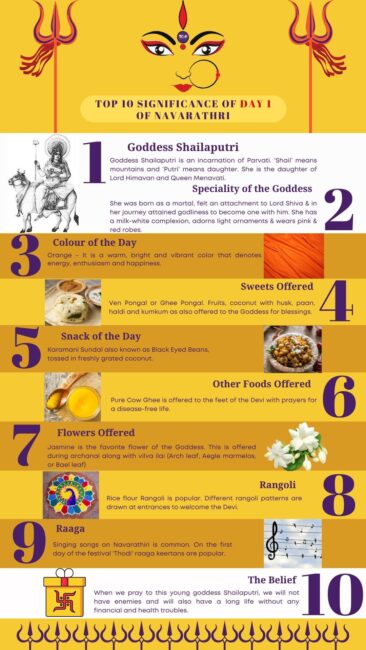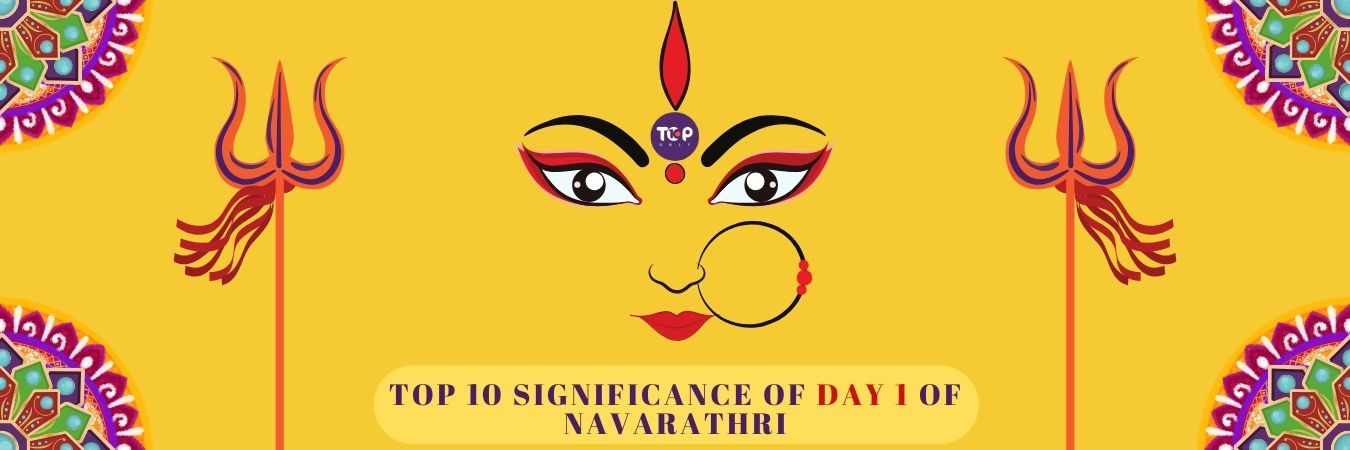
Navarathri is a very significant festival. Hindus worldwide celebrate the auspicious nine days of Navarathri with great fervour. Many devotees fast throughout the nine days of Navarathri. The celebrations include worshipping nine Goddesses in nine days and following various traditions attributed to the specific Goddess of that particular day. The festival of Navarathri culminates in the festival of Dussehra or Vijayadashami .
Top 10s Only presents a brief look at Day 1 of the Navarathri festival.
Significance of Day 1 of Navarathri
The festival of Navarathri is celebrated in memory of the intense battle that took place between Maa Durga and the fearsome demon, Mahishasura. The central theme of this festival of Navarathri is the battle and victory of good over evil based on the religious text Devi Mahatmya.
1. The Name Of The Goddess Worshipped On Day 1 Of Navarathri
Pratipada, the first day of Navarathri, is associated with the Goddess Maa Shailaputri, a manifestation of the Goddess Maa Parvati. The name ‘Shailaputri’ is a blend of two words – ‘Shail’ means mountains, and ‘Putri’ means daughter. She is the daughter of Lord Himavan and Queen Menavati, born as an incarnation of Maa Sati after her self-immolation. This form of the Goddess Maa Durga is worshipped as the wife of Lord Shiva. She is also known by several other names, such as Chamundi, Bhavani, Maaheswari, or Hemavati. Maa Shailaputri is also called Vrisharudha, as she is often depicted riding the sacred bull Nandi while holding a Trishul in her right hand and a pink lotus in her left hand. A crescent adorns Maa Shailaputri’s forehead.
2. The Speciality Of The Goddess Worshipped On Day 1 Of Navarathri
The reincarnation of Maa Sati, the Goddess Maa Shailaputri was reborn in the avatar of Shailaputri Parvati. From the moment she was born, she had felt a special attachment to Lord Shiva. According to Hindu mythology, she took birth as an ordinary mortal woman. However, she attained the status of a goddess during her journey to become one with Lord Mahadev. Her avatar is of a little daughter that makes her family happy and proud. Maa Shailaputri has a milky-white complexion, three content eyes, and a calm mien. She is adorned with light ornaments and clothed in red and pink robes.
3. The Colour On Day 1 Of Navarathri
The Navarathri day 1 colour is Orange. This warm colour signifies energy, enthusiasm and happiness. It also exudes positive energy and a vibrancy that matches the Devi, who is protective, charitable, brave and has the capacity to destroy evil. People are seen wearing this colour to mark the occasion.
4. The Sweets To Be Offered On Day 1 Of Navarathri
Ven Pongal or Ghee Pongal is prepared as the sweet delicacy to be offered as Navarathri bhog. Fruits, coconut with husk, paan, haldi, and kumkum are also offered to the Goddess Shailaputri to receive her blessings.
5. The Snacks To Be Offered On Day 1 Of Navarathri
In South India, along with this sweet, a snack called Karamani Sundal is also prepared during Navarathri. Black-eyed beans are used to prepare this snack. This snack is offered as a savoury dish to Goddess Shailaputri and is enjoyed with great relish. Dishes may differ from place to place according to each culture.
6. The Other Food Items To Be Offered On Day 1 Of Navarathri
Another offering made to Maa Shailaputri on this auspicious day is pure ghee. It is offered to the feet of the Goddess to mark the significance of Day 1 of Navarathri. It is a belief that the devotees are blessed with a healthy, disease-free life by offering pure ghee to Maa Shailaputri.
7. The Flowers To Be Offered On Day 1 Of Navarathri
Archanai with vilva ilai (Arch leaf, Aegle marmelos, or Bael leaf) and jasmine flowers are offered to the Goddess Maa Shailaputri during Navarathri Day One aarti. Jasmine is said to be the favourite flower of Maa Shailaputri.
8. The Rangoli On Day 1 Of Navarathri
Rice flour rangolis (or kolams) are created and displayed at the entrances of the houses on Day One of Navarathri. This is done to welcome the Devi Maa Shailaputri into the home. This is the time for young girls to enthusiastically show off their talents at drawing beautiful and colourful patterns.
9. The Raagam On Day 1 of Navarathri
Singing devotional Navarathri bhajans in Thodi raagam is said to please the Goddess Maa Shailaputri. So talented devotees sing beautiful bhajans in this raagam to appease Maa Shailaputri.
10. The Belief On Day 1 Of Navarathri
It is a belief that if we pray to the Goddess Maa Shailaputri, we will not have enemies and will also have a long life without any financial and health issues. Moreover, Maa Shailaputri is said to control the moon and is consequently the provider of fortunes. Thus, devotees seek blessings of good fortune by worshipping her.
Navarathri is one of the biggest and longest festivals that’s celebrated across India. Each day of the festival is important and is celebrated with great vigour. Each day of Navarathri has its own unique significance. Day 1 is dedicated to Goddess Maa Shailaputri, consort of Lord Shiva. Devotees pray to the Goddess in the hopes of attaining good health and prosperity for themselves and their loved ones.
Familiarise yourself with the traditions associated with this magnificent festival by reading the Significance Of Day 2 Of Navarathri.
We hope we covered the importance of the first day of Navarathri for you. Let us know your thoughts in the comments below.


Pingback:Navarathri Day 2 Significance - Maa Brahmacharini | Top 10s Only
Pingback:Navarathri Day 9 Significance - Maa Siddhidatri | Top 10s Only
Pingback:Top 10 Most Interesting Places to Visit In Pathankot | Top 10s Only